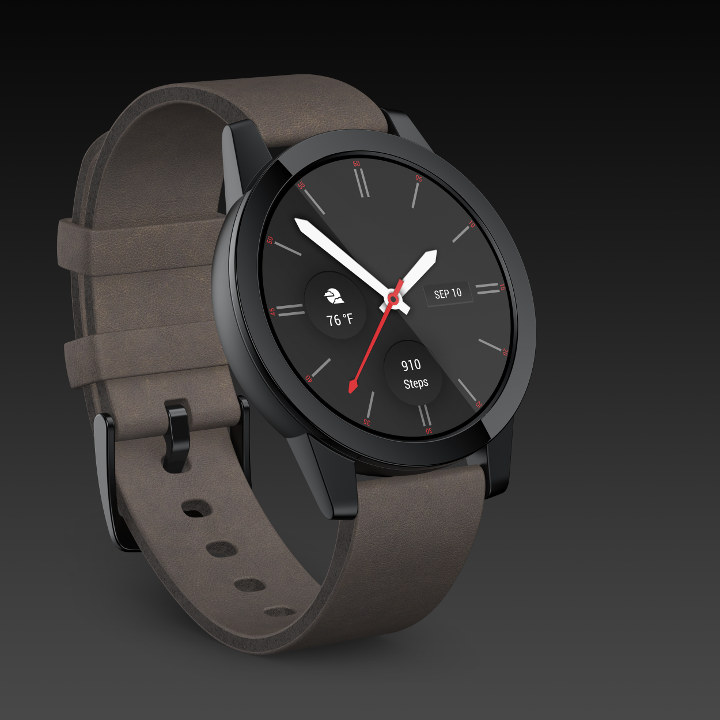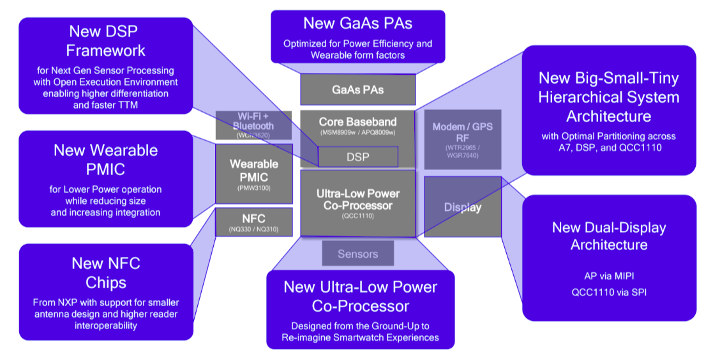Qualcomm introduced Snapdragon Wear 2100 in 2016 for wearables, and the processor ended up in several products such as LG Watch Style / Sport smartwatch.
Since then the company released other Wear platform for specific applications such as 4G kid watches with Snapdragon Wear 2500, or wearable IoT applications with Snapdragon Wear 1250 offering NB-IoT and eMTC connectivity. The company has now announced Snapdragon Wear 3100 “smartwatch platform” still based on four Arm Cortex A7 cores, but also including a new ultra-low power co-processor to further extend battery life.
 Snapdragon Wear 3100 “MSM8909w” or “APQ8009w” specifications:
Snapdragon Wear 3100 “MSM8909w” or “APQ8009w” specifications:
- CPU – Quad core Arm Cortex-A7 processor @ up to 1.2 GHz
- GPU – Qualcomm Adreno 304 GPU
- Co-processor – QCC1110
- Display – Up to 640×480 at 60fps via MIPI and/or SPI interfaces
- Cellular
- Qualcomm Snapdragon X5 LTE modem with peak download speed of 1 Gbps, and peak upload speed of 150 Mbps
- RF – WTR2965 Qualcomm RF front-end solution (RFFE); QPA4630/QSW8573/QET4101 RFFE with GaAs PAs
- Wireless Connectivity
- WCN3620 low power WiFi and Bluetooth chipset
- NXP NQ330 NFC solution
- Location
- Gen 8C Satellite – GPS, Glonass, Beidou, Galileo
- Terrestrial – Wi-Fi, Cellular triangulation
- Audio – Qualcomm Noise and Echo Cancellation, Voice Suite, Voice Activation, and Aqstic audio codec and speaker amplifier
- Security – Qualcomm Processor Security
- PMIC – PWM3100

Wear 3100 will be supported by Wear OS by Google software platform – previously known as Android Wear -, as well as an unnamed “event-driven RTOS”. Qualcomm did not provide much info about QCC1110 co-processor, but I suppose it’s probably a Cortex M3/M4 core, and the company mentions it “handles audio, display, and sensor experiences”, as well as integrate “a deep learning engine for custom workloads, such as keyword detection”.
Qualcomm also provided some indications of the extra battery life to be expected from the new processor:
This results in typical battery life day of use improvements ranging from 4 to 12 hours compared to the previous Snapdragon Wear 2100 platform, depending on display type, battery capacity, and device configurations. The new Personalized Sports Experiences keep GPS and heart rate monitoring on for the duration of the activities and is designed to deliver up to 15 hours battery life (calculated based on typical 450mAh sports watch battery). The Traditional Watch Mode, great for traveling, supports an impressive week-long battery life to the smartwatch by switching to this mode from the Wear OS by Google experience and is designed to allow consumers to enjoy basic watch functions for an extended period.
An Android Wear watch with up to one week of battery life? We’ll probably find out soon, as the company already announced their first customers with Fossil Group, Louis Vuitton, and Montblanc all planning to launch Snapdragon Wear 3100 smartwatches. Specific models include Louis Vuitton Tambour Horizon and Montblanc Summit 2. I could not find launch date estimates at this stage.

Jean-Luc started CNX Software in 2010 as a part-time endeavor, before quitting his job as a software engineering manager, and starting to write daily news, and reviews full time later in 2011.
Support CNX Software! Donate via cryptocurrencies, become a Patron on Patreon, or purchase goods on Amazon or Aliexpress





I don’t get why they insist on using the A7 as app processor (launched on 2011), when ARM clearly worked on it’s replacement with the launch of A32/A35 a couple of years ago, presenting compelling benchmarks of better performance and less power usage.
The Wear 3100 wasn’t presented as a entry level SoC, but based on the partners announced it seems targeting mid/high end smartwatch platform, so I don’t think royalty costs where an issue either.
Look at the part number on the SoC – it’s precisely the same SoC as they used with Wear 2100. Most of the ancillary chips are the same too. They mention the PMIC and NFC by name, so I assume they’ve been updated. The other difference is microcontroller between the user/display/inputs and the application processor so that can stay in it’s deepest sleep mode most of the time and not consume power.
Reasons to stick with the old? This is such a small volume product it doesn’t really deserve much investment. Keeping essentially the same hardware means they can keep the original software and product designs the same, and invest a bit of money in software for the micro.
Also minimum outlay = maximum profit.
In addition to what has already been mentioned, Qualcomm already has a license for the A7, but maybe not for the A32/35 and doesn’t want to invest in said licence. Maybe next gen?